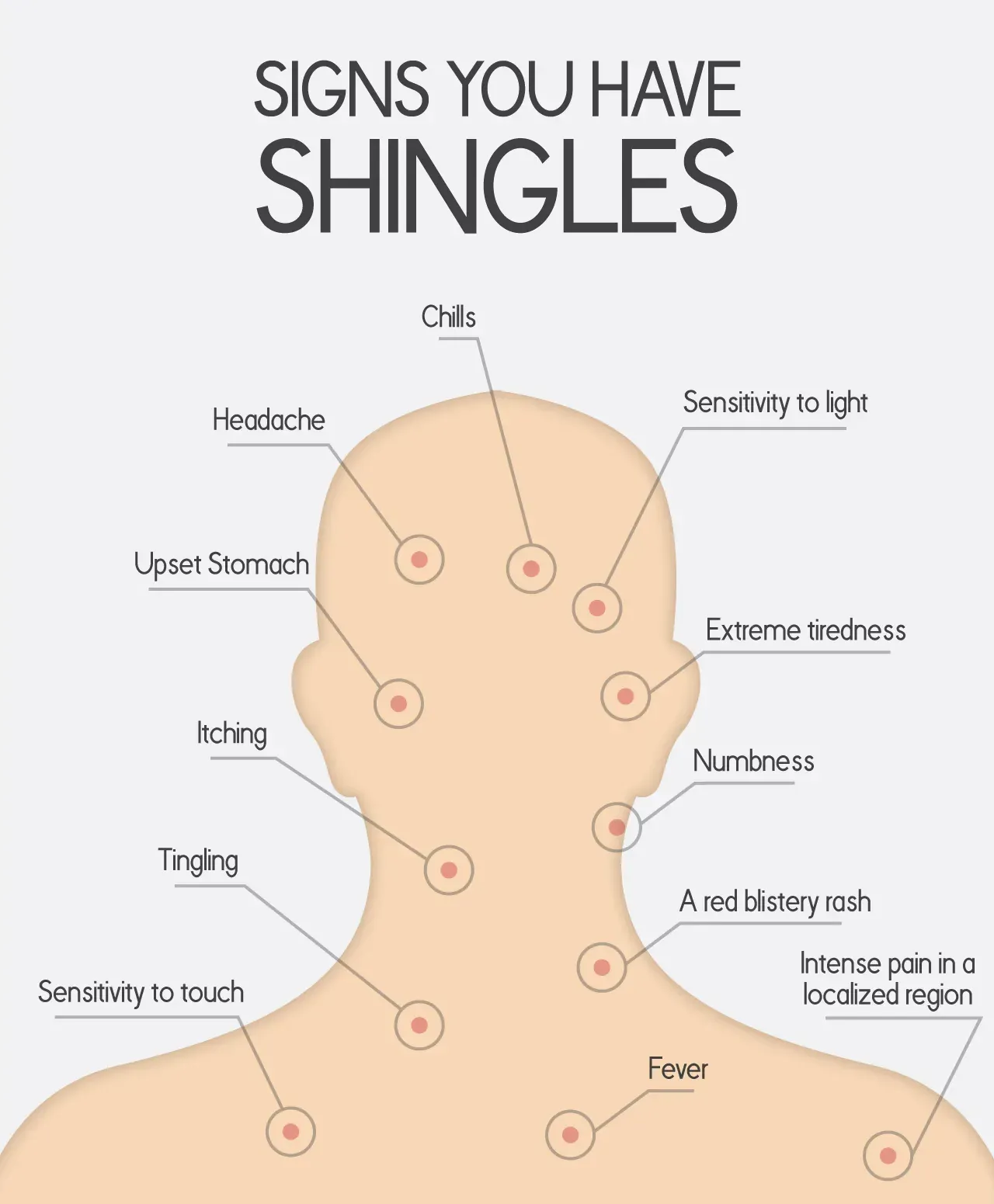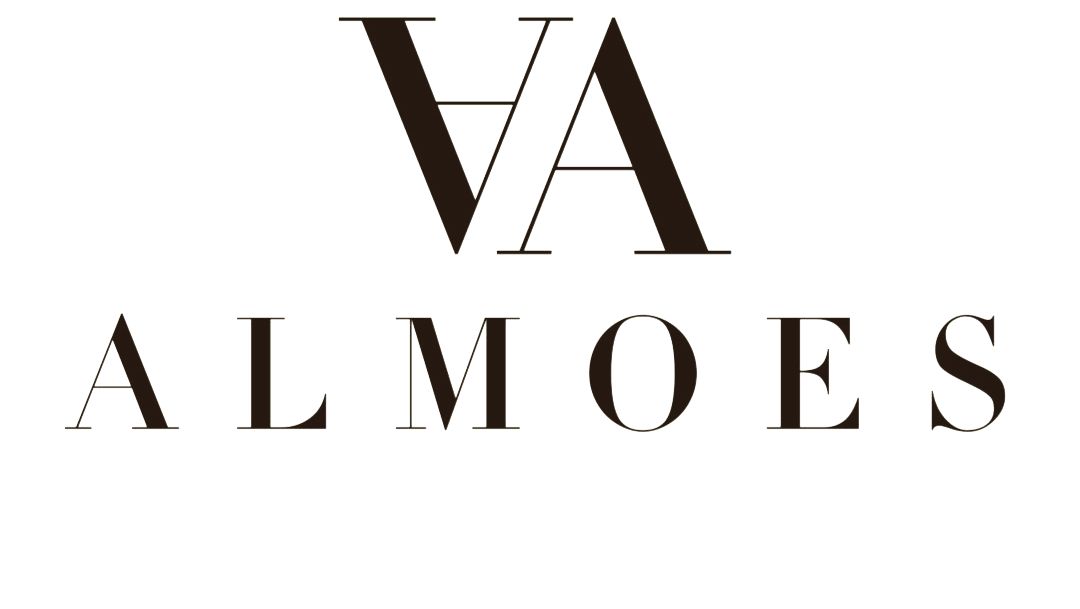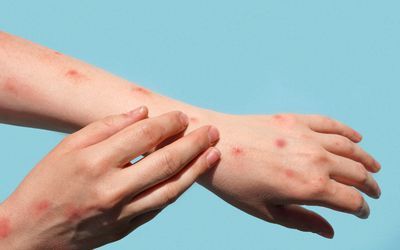Shingles
Shingles

Shingles:
Is caused by varicella zoster virus (VZV), the same virus that causes chickenpox. After a person recovers from chickenpox, the virus stays dormant (inactive) in the body. This virus can reactivate years later, causing shingles.
Clinical Features of Herpes Zoster:
- Localized zoster: most common presentation with rash in one or two adjacent dermatomes; commonly seen on the trunk along a thoracic dermatome.
- Disseminated zoster: less common presentation affecting three or more dermatomes; usually seen in people with compromised or suppressed immune systems.
- Painful, itchy, or tingly rash: usually preceded by several days of prodromal symptoms like headache, photophobia, and malaise.
- Vesicular rash: clusters of vesicles develop and new vesicles continue to form over three to five days, eventually drying and crusting over.
- Healing time: usually takes two to four weeks for the rash to heal, but permanent pigmentation changes and scarring may occur.
Complications of Herpes Zoster:
- Postherpetic neuralgia (PHN): the most common complication, with persistent pain in the area where the rash was for more than 90 days after rash onset.
- Ophthalmic involvement: herpes zoster ophthalmicus with acute or chronic ocular sequelae, including vision loss.
- Bacterial superinfection: of the lesions, usually due to Staphylococcus aureus and, less commonly, due to group A beta-hemolytic streptococcus.
- Cranial and peripheral nerve palsies: nerve damage that can cause weakness, paralysis, or other complications.
- Visceral involvement: such as meningoencephalitis, pneumonitis, hepatitis, and acute retinal necrosis.
- Complications in immunocompromised individuals: more severe, long-lasting rash and higher risk of developing disseminated herpes zoster.
Vaccination for Herpes Zoster:
- Recombinant zoster vaccine (RZV, Shingrix): recommended vaccine to prevent shingles and its complications.
- Recommended age group: adults 50 years and older.
- Immunocompetent adults: should get two doses of Shingrix, 2 to 6 months apart, whether or not they have already had herpes zoster or previously received Zostavax®.
- Protection against herpes zoster and PHN: two doses of Shingrix are more than 90% effective at preventing herpes zoster and PHN.
- Long-lasting protection: protection stays above 85% for at least the first four years after vaccination.
Overall, the recombinant zoster vaccine (RZV, Shingrix) is highly effective at preventing herpes zoster and its complications, including PHN. Vaccination is recommended for adults 50 years and older, whether or not they have previously had herpes zoster or received Zostavax.
Zostavax is no longer available for use in the United States, as of November 18, 2020.
Disease Rates, Recurrence, Complications, and Deaths for Herpes Zoster:
- Annual incidence: approximately 4 cases per 1,000 U.S. population, with an estimated one million cases occurring annually in the United States.
- Incidence among people 60 years and older: about 1 case per 100 U.S. population annually.
- Repeat episodes: multiple episodes of herpes zoster can occur, but the precise incidence of recurrence is not known. Most people have only one episode of herpes zoster in their lifetime.
- Complications: approximately 1 to 4% of people with herpes zoster get hospitalized for complications. About 30% of all people hospitalized with herpes zoster have compromised or suppressed immune systems. About 1 in 10 adults with herpes zoster develop PHN.
- Deaths: one study estimated that 96 deaths occur each year in which herpes zoster was the actual underlying cause (0.28 to 0.69 per 1 million population). Almost all deaths occur in older adults and those with compromised or suppressed immune systems.
Overall, herpes zoster is a relatively common disease with the majority of cases occurring in older adults. While most people have only one episode of herpes zoster in their lifetime, complications such as hospitalization and PHN can occur in a significant percentage of cases. Vaccination with the recommended vaccine, Shingrix, can help prevent herpes zoster and its complications.
References
- CDC. Prevention of herpes zoster: recommendations of the Advisory Committee on Immunization Practices (ACIP) Recommendations for use of Herpes Zoster Vaccines. MMWR Recomm Rep. 2018;67(03):103-108.
- Thomas SL, Hall AJ. What does epidemiology tell us about risk factors for herpes zoster? Lancet Infect Dis. 2004;4(1):26-33.
- Tseng HF, Smith N, Harpaz R, Bialek SR, Sy LS, Jacobsen SJ. Herpes zoster vaccine in older adults and the risk of subsequent herpes zoster disease. JAMA. 2011 Jan 12;305(2):160-6.
- Mahamud A, Marin M, Nickell SP, Shoemaker T, Zhang JX, Bialek SR. Herpes zoster-related deaths in the United States: validity of death certificates and mortality rates, 1979-2007. Clin Infect Dis.2012 Oct;55(7):960-6.
- Leung J, Harpaz R, Molinari NA, Jumaan A, Zhou F. Herpes zoster incidence among insured persons in the United States, 1993-2006: evaluation of impact of varicella vaccination. Clinical Infectious Diseases. 2011;52(3):332-340.
- Yih W, Brooks D, Lett S, Jumaan A, Zhang Z, Clements K, Seward J. The Incidence of varicella and herpes zoster in Massachusetts as measured by the Behavioral Risk Factor Surveillance System (BRFSS) during a period of increasing varicella vaccine coverage. BMC Public Health. 2005;5(68).
- Jumaan AO, Yu O, Jackson LA, Bohlke K, Galil K, Seward JF. Incidence of herpes zoster, before and after varicella vaccination-associated decreases in the incidence of varicella. Journal of Infectious Diseases. 2005;191:2002-7.
- Hales CM, Harpaz R, Joesoef MR, Bialek SR (2013). Examination of links between herpes zoster incidence and childhood varicella vaccination. Annals of Internal Medicine. 159(11):739-45
- Russell ML, Dover DC, Simmonds KA, Svenson LW. Shingles in Alberta: before and after publicly funded varicella vaccination. Vaccine. DOI 10.1016/j.vaccine.2013.09.018.
- Weinmann S, Chun C, Schmid DS, Roberts M, Vandermeer M, Riedlinger K, et al. Incidence and clinical characteristics of herpes zoster among children in the varicella vaccine era, 2005–2009. Journal of Infection Diseases. 2013;208(11):1859-68.
- Hardy I, Gershon AA, Steinberg SP, LaRussa P. The incidence of zoster after immunization with live attenuated varicella vaccine. A study in children with leukemia. Varicella Vaccine Collaborative Study Group. N Engl J Med. 1991;325(22):1545-50.



